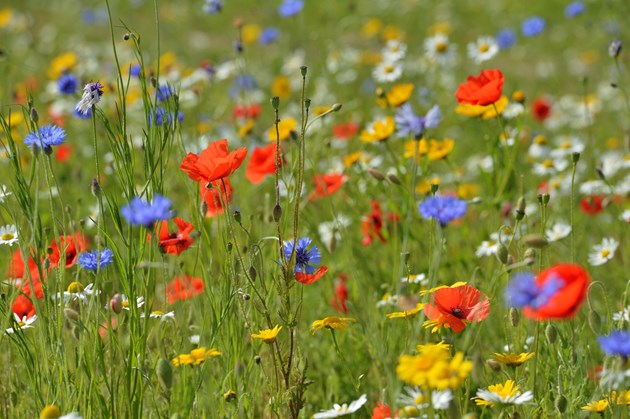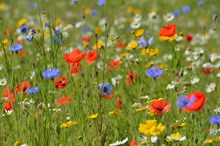10 January, 2022
Nature fund celebrates ‘1,500 football fields’ of new and improved habitats in Scotland

A nature fund that began just three years ago is celebrating local projects across Scotland coming together to plant more than 160,000 native trees, sow 60,000 seagrass seeds and create nearly 600 hectares - 1,500 football fields-worth - of new or improved habitat for our pollinators, vulnerable birds and wildflowers.
The Biodiversity Challenge Fund specifically encouraged applicants with innovative projects that improve biodiversity and address the impact of climate change, by increasing the resilience of our most at-risk habitats and species and creating large areas of new or restored habitat.
According to the 2019 State of Nature report, since 1990, we have seen a 24% decrease in species abundance since 1994 and 11% species potentially at risk of extinction in Scotland due to climate change and other pressures. The Fund has supported over 40 ambitious, large scale projects with total funding of nearly £7m. Since 2019 achievements to date by the Fund’s successful applicants include:
- Almost 1,500 football pitches-pitches worth of new or improved natural habitats, including 246 hectares of wildflower and species rich habitats created or restored across Scotland, 232 hectares of nesting habitat created or improved for Scotland’s vulnerable wading bird populations, including lapwings and curlews; and Inner Forth Futures Wetland Habitat Network partnership’s project’s improvement work with 110 hectares of wetland, including creation of 7 new ponds.
- More than 160,000 trees planted in and around areas such as montane habitats and riverbanks, bringing much needed shade, and nutrients such as leaf litter and insects for Atlantic salmon and freshwater pearl mussel, and connecting and expanding vital habitats.
- More than 60,000 seagrass seeds planted in hessian bags and tethered to the seabed, as part of the Seawilding community-led Seagrass Restoration Project in Loch Craignish. Seagrass has a key role to play globally in biodiversity restoration and protection, providing food and shelter for thousands of different species, which in turn supports the livelihoods of fishing communities; while mature seagrass beds have the potential to help slow coastal erosion.
- Scottish Canal’s creation of a home for fish, insects, amphibians, birds and mammals at Glasgow’s Pinkston Basin. The project features a micro wilderness of over 3,600 aquatic plants – an ideal habitat for millions of microorganisms, which use algae, carbon and excess nutrients as a food source and purify the water.
As the Biodiversity Challenge Fund begins to reach a natural end, it is being replaced by a multi-year package of at least £65 million over the next five years. The new Nature Restoration Fund, launched in November last year, is set up through a Scottish Government fund following agreement with the Scottish Green Party. Starting this year it will back projects that address the biodiversity and climate crises by putting Scotland's species, woodlands, rivers and seas back on the road to recovery.
Biodiversity Minister Lorna Slater said:
“Too much of our planet’s natural environment is degraded after years of over-exploitation, and Scotland is no exception – that’s why we are taking action to restore our valuable natural assets and support our wildlife. It is extremely gratifying to see the progress that has been made through the Biodiversity Challenge Fund, and I commend all those involved for their commitment and innovation through projects which are helping to restore and improve habitats and ecosystems.
“Our Nature Restoration Fund kick starts a new approach, including support for longer-term, larger, landscape-scale projects across Scotland - on land and at sea - that address the twin crises of biodiversity loss and climate change. Over this parliament we will invest at least £65 million through the fund, delivering real change that will help revive our natural environment.”
NatureScot Chief Executive Francesca Osowska added:
“We want to celebrate the incredible achievements of people and organisations across the country. Supported by the Biodiversity Challenge Fund, and in just three years they have made our communities more sustainable and more resilient.
“As we look forward to this year’s COP15 in China and its focus on global biodiversity, it is projects like these and the new Nature Restoration Fund that make the difference and set us on the road to a nature positive, net zero future.”
Contact information
- Name
- Cat Synnot
- cat.synnot@nature.scot
Notes to editors
The aim of the Biodiversity Challenge Fund has been to enable targeted action for priority habitats and species, accelerating efforts that will help create transformational change to increase the biodiversity value of land and sea with a focus on nature based solutions to address the impacts of climate change and biodiversity loss.
Fulfilling a commitment initially made in the 2018 Programme for Government to establish a Biodiversity Challenge Fund, in summer 2019 NatureScot commenced administering investments of around £1.8 million to create and improve habitats for key species and encourage increased access to nature over the following 2 years. With a number of additional projects from the first round subsequently receiving funding offers and a second, £2 million round running in 2020 last year despite the challenges posed by the Covid-19 pandemic, and a third and final round in 2021, total funding made available to the Biodiversity Challenge Fund is around £7m.
The Nature Restoration Fund supports action on the ground to address the biodiversity and climate crises by aiding nature restoration in Scotland’s terrestrial and marine environment, enabling transformative change through large-scale, multi-year, multi-partner projects. This forms part of the wider commitment to invest £500 million in the natural economy over the course of the parliament to support a transformative approach to protecting and restoring Scotland’s biodiversity.
Funding will comprise of at least £13.5 million for each year of the current Parliament session (£11 million CDEL and £2.5 million RDEL per year), plus £1 million across the Parliament for administrative costs.
NatureScot is Scotland's nature agency. We work to enhance our natural environment in Scotland and inspire everyone to care more about it. Our priority is a nature-rich future for Scotland and an effective response to the climate emergency. For more information, visit our website at www.nature.scot or follow us on X at https://x.com/NatureScot
’S e NatureScot buidheann nàdair na h-Alba. Bidh sinn a’ neartachadh àrainneachd na h-Alba agus a’ brosnachadh dhaoine gu barrachd suim a chur ann an nàdar. Tha e mar phrìomhachas againn gum bi nàdar na h-Alba beairteach agus gun dèilig sinn gu h-èifeachdach le èiginn na gnàth-shìde. Tha an tuilleadh fiosrachaidh aig www.nature.scot no air X aig https://x.com/NatureScot

